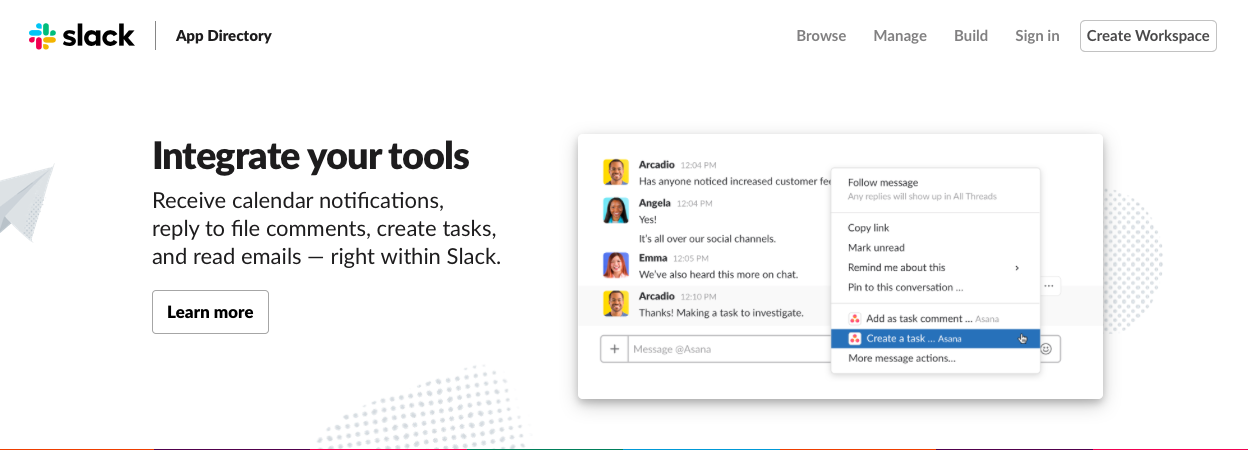Why we integrate: Why smart companies build ecosystems

.png)

.png)
Once upon a time, leading software companies were on a mission to provide all-in-one products that would—in theory—be able to handle every customer’s needs with a sprawling, broad-but-shallow feature set.
These companies found that this strategy quickly ran aground on a hard truth: You can’t please all of the people all of the time.
After realizing that it just wasn’t possible to fulfill the wishes of each and every customer with a single product, companies started creating platforms that were extensible by third-party developers. This strategy opened up a whole new world of possibilities, but it came saddled with its own set of limitations.
And limitations aren’t part of a winning formula when you live in a world where software evolution seems to take place at the speed of light, and voracious software adoption is the new norm.
Today, the average mid-sized business uses more than 150 different software products across their organization. It’s no wonder that it’s no longer feasible to build a single SaaS solution that can handle all the evolving needs and use cases of a modern business.

Luckily for everyone—businesses and software companies alike—we’re entering a new era: the era of the product ecosystem.
It’s no longer just about single tools or platforms. It’s no longer just about vertical or horizontal business models. It’s about building integrated ecosystems that create mutually beneficial connections between products in order to deliver more value to users.
Read more: Key terms defined: Products, tools, platforms, and ecosystems
An ecosystem is about interconnection, which—in the world of software—translates into integrations. More specifically, a successful product ecosystem is about building integrations with intent: the intent to grow both of the connected companies, and the intent to provide value to the end user.
Keep in mind that intent is the key thing, then you can start to think about the different options for creating the connections that are the structural backbone of your ecosystem.

An open API allows other entities to build their own integrations to connect with your product or platform. This ubiquitous method is used in a wide variety of use cases to facilitate communication between one piece of software and another. The key word here is “communication,” and it applies well beyond the actual connection to include the API documentation.
Before any developer makes use of your API, they are first going to read your documentation. If you want things to go well, that documentation had better be stellar. That means it needs to provide helpful onboarding guidance, a full explanation of authentication, sample code, interactive demos, real-life examples, and an organized reference framework. Also, you’ll need to keep that documentation updated.
A second option is to make use of citizen integrator tools like Zapier and IFTTT. These companies allow people to connect and automate the apps they use. They also maintain a library of existing integrations that can be implemented with a few clicks.
The Appcues <> Zapier Integration, for example, gives our users the ability to quickly and easily connect with more than 1,500 other tools to automate all kinds of business tasks.
The opportunities provided by this integration are almost limitless, and they are especially geared to help empower product-led companies who are able to create seamless product experiences by allowing all the products in their tech stacks to talk to each other.
The final option is to build your own integration. This allows a more tailored approach that makes the integration feel more organic and also makes it possible for each of the integrated apps to take full advantage of the other’s capabilities. This can be, however, a more time-consuming and costly option as it requires specific skill sets and expertise.
In addition to the different ways to create connections between apps, there are 2 main types of integrations to consider:
The simpler type of integration, data integrations allow you to sync data across 2 or more systems. This allows you to share information across multiple apps in real time. This type of integration is generally used to centralize information from multiple sources so that it’s more accessible and actionable. While the mechanics of data integrations are fairly straightforward, there are a lot of related issues to consider if you want the integration to be successful and sustainable: master data management (MDM), deduplication, data flow design, data governance, and so forth.
On the more complex end of the spectrum, we have process integrations. Process integrations allow for task automation by making it possible for one app to trigger an action in another app. So, instead of just passing data back and forth, these integrations allow the receiving app to take action based on the content of the shared data. These types of integrations require more work in the design and testing phase, and also require consistent updating to ensure they continue performing the desired automation.
One of the best attributes of a successful product ecosystem is that it creates a constantly renewing cycle of benefits for both the integrated product companies and the end users. It’s a true win-win-win.
Powerful integrations are designed to enhance the user experience. Typically, this means that they make the user’s life easier by centralizing content in one place, automating tasks, or otherwise removing friction and increasing efficiency. Integrations make it possible for users to get their work done without having to leave their preferred software environment.
Scott Brinker, VP of Platform Ecosystem at HubSpot, talks about this idea using the concept of the “one-window test.” The term refers to how much work a user can complete within a single window or tab. The results are an indicator of how well the user’s technology stack is integrated. Again, the primary goal is to simplify things for the user by connecting all the tools together in one place, and—where possible and appropriate—enabling task automation across apps.
The ecosystem benefits for product companies vary depending on the role of the company. In 1-way integrations, there are specific benefits for the “host” or platform company, and other benefits for the integrated product. Meanwhile, 2-way integrations can provide similar benefits to both companies.
Right out of the gate, an ecosystem gives you the luxury of maintaining focus on your core business. It lets you stay squarely in your wheelhouse instead of being pulled in multiple (and potentially fruitless) directions.
While you’re staying in your lane with your core product and mission, user-centric integrations make it easy to increase your product’s value to end users. You can add features and functionality without having to tap your own development or engineering resources. For example, Trello users who love the app’s visual collaboration tools for project management kept asking Trello to add Gantt charts. Instead of building out their own Gantt chart feature, Trello integrated with Elegantt to deliver instant value.

Everyone knows how important retention is to a company’s long-term health. And a big part of improving retention has to do with encouraging users to create habits around your product. Product ecosystems help centralize tasks and workflows, which increases the amount of time users spend in your product. Integrations can also help surface features and functionality which users may have overlooked, again helping to deepen their engagement with your product.
As a result of stronger user habits and deeper engagement, you will be able to collect more usage and behavioral data. You can then use this data to gain insight into things like where users get tripped up, which features are most popular, when there are opportunities to introduce new features, and all kinds of other information that will help you improve the user experience and boost the value your product delivers.
On both sides of the equation, a product ecosystem can power faster growth. All the benefits already listed combine to strengthen a company’s market position and ability to reach new customers. Software ecosystems are also often fertile ground for innovation based on the collaboration between different product teams.
Finally, being part of a product ecosystem gives product companies the chance to forge more open and collaborative relationships with partner companies. Tactically, a product ecosystem is an excellent way for up-and-coming product companies to access the built-in audiences of more established products.
The appeal of this go-to-market strategy is gaining direct access to the right users without the need for heavy lifting in the sales and marketing departments. Strategically, these ecosystem-driven relationships can positively affect industry credibility and open the door to additional opportunities for both newcomers and more established companies.

If you want to ensure that everyone involved gets the most out of your product ecosystem, there are a few things that deserve your upfront attention.
First things first, you need to start with a clear intention that’s all about helping your users achieve something they care about. Don’t fall into the trap of thinking you know best and forging ahead with an integration before you’ve even validated that it’s something your users want. “If you build it, they will come” is an especially dangerous trap when it comes to ecosystems. To attract other companies to your ecosystem, you need to be solving a real pain for your mutual customers.
Inexperienced product teams will often embed integrations into their main source code. This is a mistake. The better strategy is to create an architectural layer that allows you to keep integrations separate from your core product while allowing you maximum flexibility. Typically, this entails using an API to expose your data and functionality as needed for the integration.
As the old saying goes—garbage in, garbage out. With integrations, any data problem is instantly multiplied because your data exists in 2 or more applications at once. Build in semi-regular audits to assess any issues and ensure that your data is clean and consistent. It’s also important to understand the nature of your integration—real time or batched—so you have a better sense of how to ensure data accuracy.
The technical debt of API integrations can escalate fast. It’s easy to get off track if you only pursue the quick wins without thinking through how what you’re doing will affect the user experience in the future. Everyone wants to ship fast, but in situations that require heavy, complex coordination, it pays to take things a little slower. Factor in issues like system depreciation, changes in APIs, and so forth. And test as much as you can. Putting this effort in upfront will help you avoid disappointing users when you launch.
In the early stages, it’s easy to focus too much on immediate needs; but it’s critical to think about how those needs might evolve. A solution that can handle 200 operations per second might work in the beginning, but what happens when that volume increases to 1,000 or 10,000? Think through what could break if the volume, speed, or complexity of the demand on your integration changes substantially.
We can’t emphasize this enough. Detailed, thorough, up-to-date documentation will make your partners’ lives (and yours!) much, much easier. Try not to leave this critical element to the last minute. Documentation should never be an afterthought. It is, after all, the first thing your integration partners will see. If your documentation makes a bad impression, your collaboration might be over before it starts.

You started this integration journey with the user in mind. Once your integration is up and running, you want to circle back and make sure that your integration is serving the user and the overall ecosystem in the way you intended. Track who is using your integration, who has upgraded or downgraded, converted or churned. It’s not always easy to discern correlation from causation, so don’t jump to conclusions. But do pay attention to what’s happening so you can take advantage of any opportunities to optimize the situation.
As organizations continue to adopt a wide variety of products and apps to get their work done, the need for product ecosystems will increase. And the defining feature of successful ecosystems will be a sharp focus on intentional, high-quality integrations designed to improve the user experience through ease and efficiency. This will be what separates the leaders from the rest of the pack.
Because it turns out that you can please all the people all of the time, IF you know how to design and build a strong and effective product ecosystem that delivers more value to users.
That’s exactly what we’re committing to here at Appcues. We are developing our own Appcues integrations that connect us with popular analytics, email, and data software so you can measure and create seamless user experiences across channels. We have also launched the Appcues <> Zapier Integration, which delivers access to more than 1,500 products.
And, as if that weren’t enough, our new Growth Lab features an ever-growing collection of actionable experiments to help your product drive results. We’re publishing new product ecosystem formulas each week to help power better experiences in support, sales, marketing, growth, and customer success.
